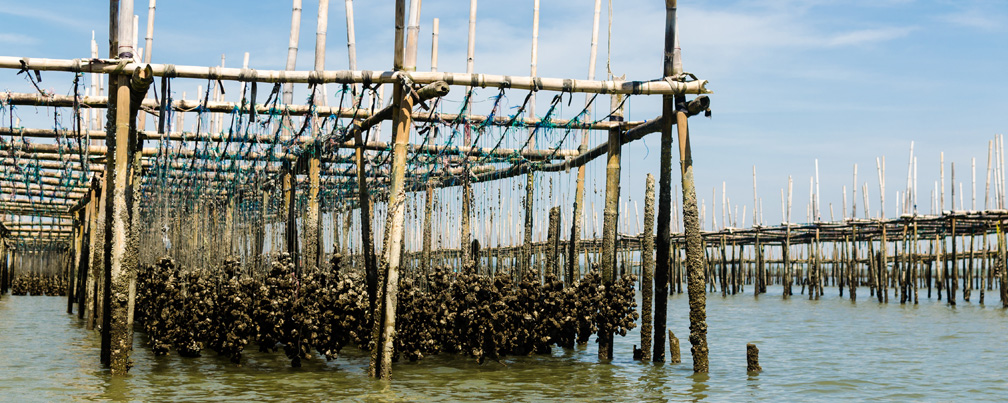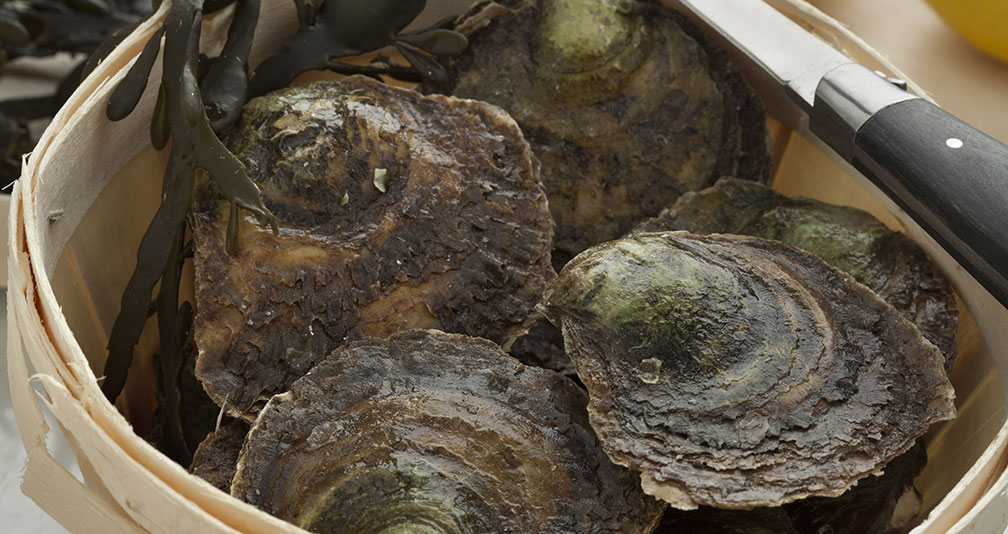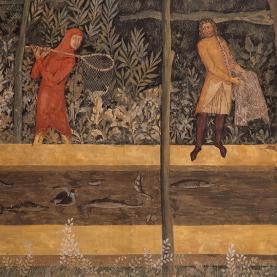Oyster
Oysters were farmed during Antiquity, as the Greeks and Romans were partial to this mollusc. From the 17th century, demand was so high that natural beds began to deplete. Modern oyster farming developed in the 19th century. Contemporary techniques vary depending on the place of cultivation and local traditions. It takes two to three years for an oyster to grow to a marketable size. Researchers have developed sterile triploid oysters, unable to reproduce, that can be eaten all year round.
A highly prized shellfish
Oysters are bivalve molluscs belonging to the Ostreidae family and which stick to rocks or remain in the silty depths. Prehistoric coastal populations ate oysters. During Antiquity, in the Mediterranean Basin, they were a firm favourite of the Greeks and, later on, would charm the Romans, who brought them back from the Mediterranean and the Atlantic to create oyster beds. In turn, Gaul also started oyster farming. However, the end of the Roman Empire sounded the death knell for oyster culture, and consumption remained low for several centuries.
Oysters made a strong comeback in the 17th century, particularly in Paris. They were expensive and highly sought after, and thus became a victim of their own success. During the 19th century, natural oyster beds were overharvested and gradually depleted, hence modern oyster farming began to emerge.
This mollusc can be eaten raw or cooked, roasted, in wine or in a sauce, or in more elaborate recipes such as oysters Rockefeller.
Oyster farming
The cupped Pacific oyster, Crassostrea gigas, has been the most widely farmed species of oyster since the 1970s. Originally from Japan, it was introduced across the world to replace stocks depleted by overharvesting or decimated by disease, such as those of the European flat oyster, Ostrea edulis, which declined from the 1920s.
Several different techniques are used to farm oysters, depending on the place, the species and local traditions. Oysters are cultivated on the foreshore (the part of the coastline between high- and low-water marks), in ponds or in the open sea. They may be raised off the seabed, placed in bags laid flat on tables. With suspended culture, they are attached to ropes hanging from a table or a floating system, and are permanently immersed. In the open sea, oysters are grown with the long-line method, with cages suspended from cables or rafts.
Oysters are refined in large salt ponds, called claires, where the water is less saline but rich in plankton. It is here that oysters obtain their flavour and colour. During the finishing stage, oysters are placed in water of impeccable quality, where they are washed and sorted. Depending on the species and breeding conditions, it takes two to three years for an oyster to reach a marketable size.
Sale
Oysters are graded into different sizes for sale, from grade 0 to grade 5, the lightest. Clear, purified oysters are labelled as claire oysters, labelled with the French terms fine, spéciale, fine de claire and spéciale de claire depending on how long they have spent in the refining basin and the density of oysters per square metre. They may also be sold under the name of the area in which they were grown.
Months without the letter ‘r’
It is traditionally recommended not to eat oysters during months without the letter ‘r’ in their name, meaning between May and August. This corresponds to the period of reproduction, when oysters become milky and soft, but are still edible. However, at this time, oysters are less tasty and will spoil more quickly. Researchers have developed a ‘four-season’ oyster, the triploid, which is artificially sterile and contains three sets of chromosomes rather than the pairs typically found in natural oysters. Triploids have been marketed since the beginning of the 2000s, and now account for 50% of oysters sold today.
D’Amico, Serge, 1997, L’encyclopédie des aliments, Paris : Editions Fontaine.
Helm, M.M, Programme d’information sur les espèces aquatiques cultivées Crassostrea gigas, dans Département des pêches et de l’aquaculture de la FAO, Rome, avril 2005,
http://www.fao.org/fishery/culturedspecies/Crassostrea_gigas/fr, consulté le 20 mai 2016.
Toussaint-Samat, Maguelonne, 1997, Histoire naturelle et morale de la nourriture, France : Larousse
Ducasse, Alain. Mon Grand Livre de Cuisine: recette et techniques d'Alain Ducasse (pour iPad). s.l. : Alain Ducasse Edition.









